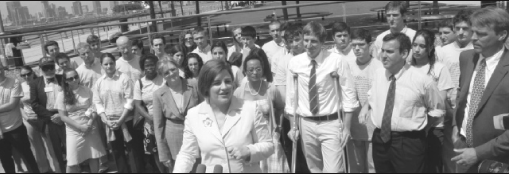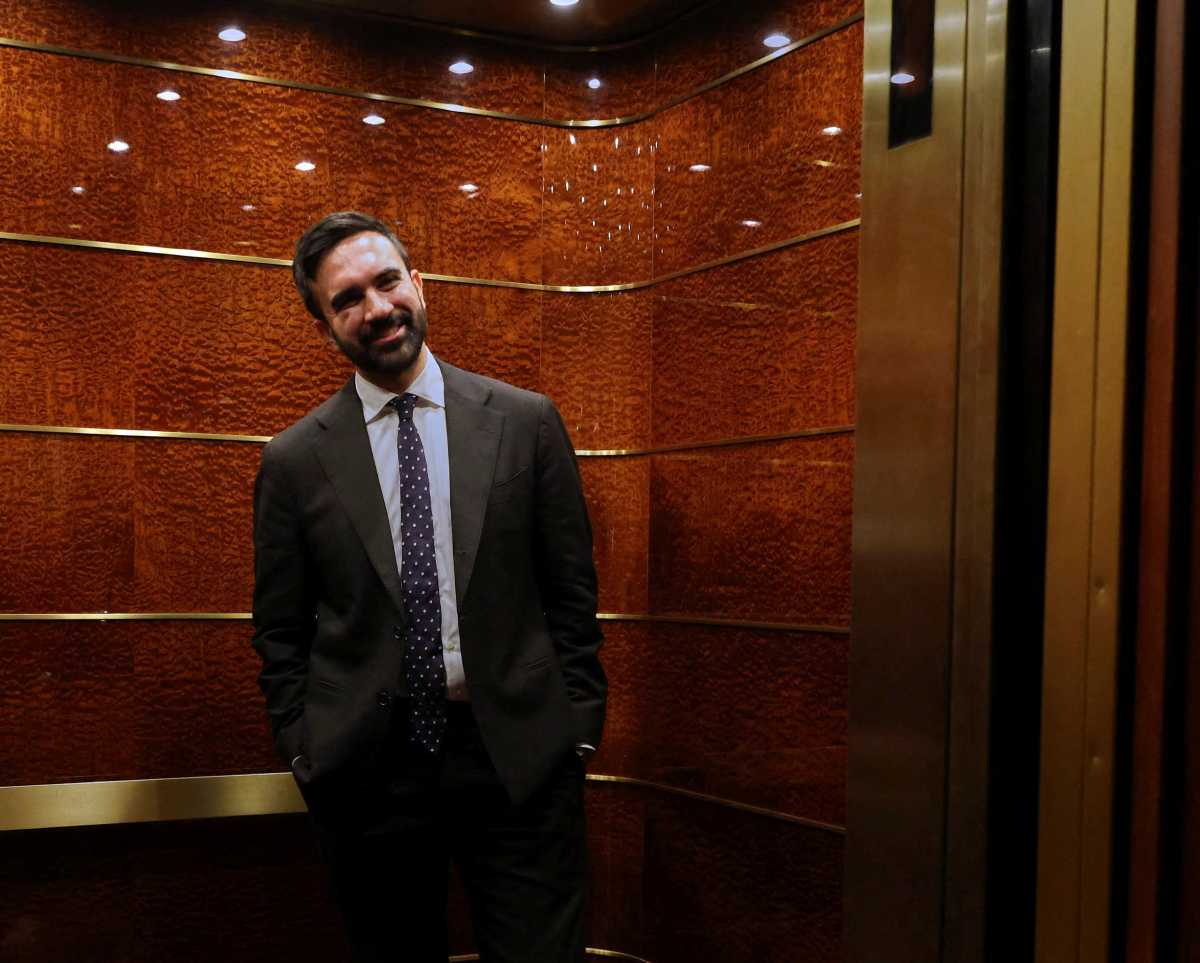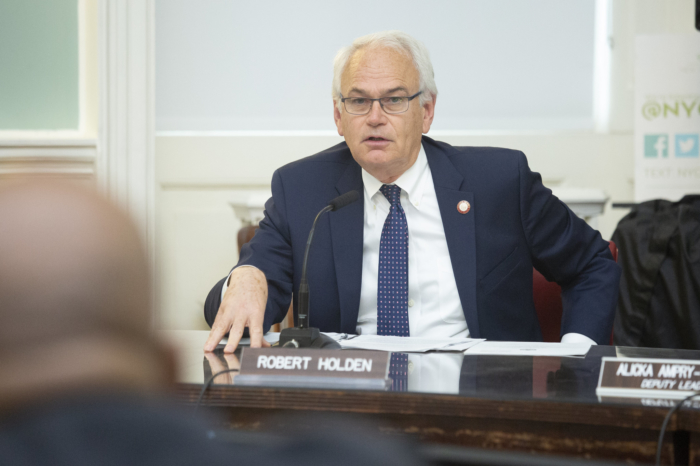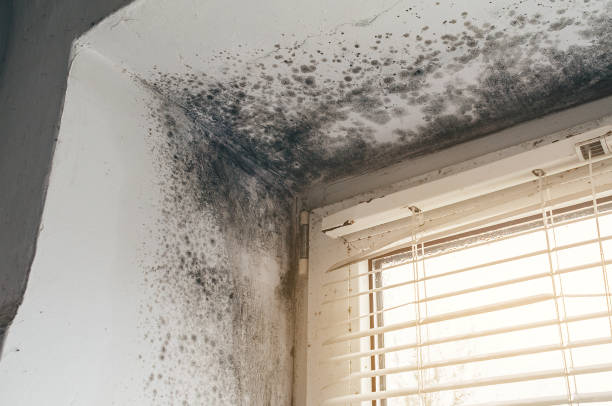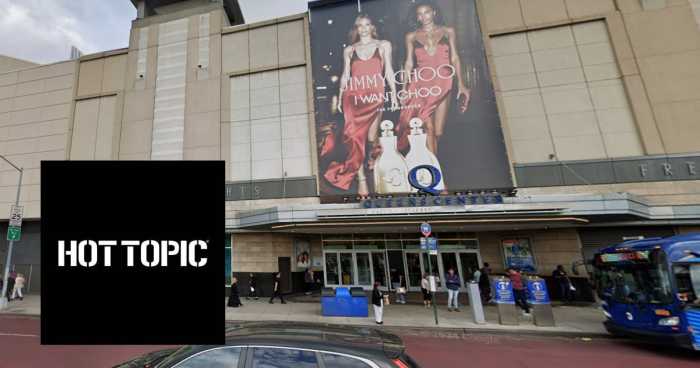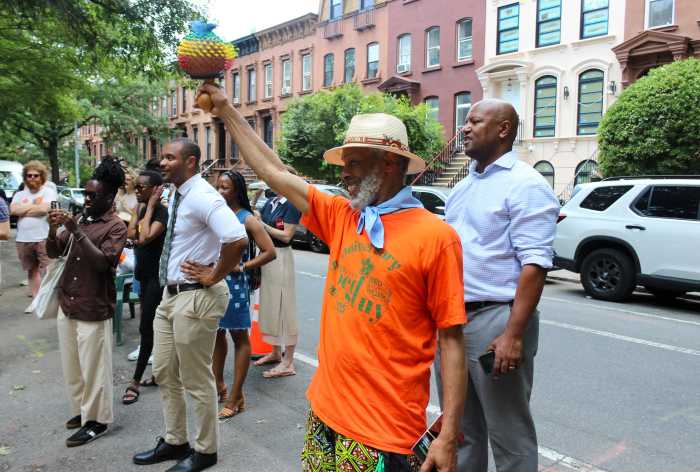By Josh Rogers
Volume 20 Issue 6 | June 22 – 28, 2007
City Council Speaker Christine Quinn, with environmentalists, in the Hudson River Park on Monday, announced her support for the mayor’s congestion pricing plan.
Traffic relief now,not next year, Soho says
“Step outside,” the senior citizen said, challenging a police commander Monday night. After all, some Downtowners have dealt with Holland Tunnel traffic longer than others.
The man, who has lived all of his 66 years in a neighborhood now known as Soho, was not threatening the commander at the community meeting, he just wanted the officer to see what the late-day rush hour is like every night on Broome St. Outside the Puffin Room gallery, crossing pedestrians weaved through mostly idling cars backed up to Mercer St. and the drivers slowly inched the six long blocks to the free ride through the tunnel to New Jersey. West Broadway and other cross streets were equally jammed.
The lanky, bald senior, who declined to give his name, was angry when Dep. Inspector Michael Pilecki seemed unaware of the problem, even though the commander has been in charge of Lower Manhattan traffic enforcement since 9/11.
Councilmember Alan Gerson, who had organized the town hall forum on traffic, had just asked Pilecki what needed to be done to get traffic agents on Broome. Pilecki congratulated Gerson for taking the first step — letting police know about the problem.
This triggered catcalls from the audience, shocked that Pilecki was first learning about the situation. “It wasn’t brought to your attention before,” one man shouted out. “It’s been going on for years.”
People called out other nearby streets that also needed attention — Spring, Varick and others. When one resident asked for a commitment to put traffic agents along Broome St. by this weekend, Pilecki said he couldn’t take that many officers off other busy Downtown streets such as Canal, but he did promise he would put an agent on the most jammed intersection, Broome and W. Broadway.
Although there has been a lot of news coverage about Mayor Bloomberg’s toll plan in recent weeks — and this was a group of people who care enough about traffic to show up to a transportation meeting — congestion pricing was hardly mentioned. Judging by the answers to questionnaires distributed by Gerson, who has not taken a position on the mayor’s plan, a solid majority of the 30 or so in the room supported congestion pricing.
Bloomberg’s plan would impose a flat $8 fee on rush hour car drivers ($21 for trucks) entering Manhattan streets south of 86th St. in an effort to reduce pollution and raise money for mass transit investment. Residents living in the zone would pay $4 if they drove around Manhattan between 6 a.m. and 6 p.m. weekdays. The proposal faces an uphill fight in Albany, whose legislative session was expected to end June 21 without passage. Mary Peters, U.S. Transportation secretary, said the city’s plan has a good chance to get $500 million in federal money to implement it if it is passed by August, and Gov. Eliot Spitzer, who backs the general concept, has said he would call a special legislative session in July to pass a congestion pricing bill.
Critics of the mayor’s plan say it would overwhelm neighborhoods outside the zone with parking problems, be unfair to lower income car owners and would reduce privacy because there would be too great an increase in surveillance cameras.
Assembly Speaker Sheldon Silver, whose support will be crucial for passage, softened his skepticism about traffic pricing at a joint press conference with the mayor and governor last Thursday, after they announced the deal to bring JPMorgan Chase to the World Trade Center.
“We are working on congestion pricing — or congestion in Manhattan right now,” said Silver, whose district includes much of Lower Manhattan. “It’s not, ‘are we going to work?’ We are working.” Bloomberg praised Silver for inviting the mayor to be the first witness in the Assembly hearings on the plan a few weeks ago.
Another Downtown legislative leader, City Council Speaker Christine Quinn, whose district includes Hudson Square, the Village and Chelsea, announced her support for the mayor’s plan Monday, coincidentally a few hours before the traffic meeting.
Gerson steered clear of the subject Monday night, although he did suggest he was in favor of a new traffic policy saying “the political stars are aligned.”
Carl Rosenstein, Puffin’s owner, spoke of “Bloomberg’s courageous congestion pricing idea,” a statement which drew neither a positive or negative reaction from the otherwise lively audience. Attendees seemed more interested in getting relief this week rather than the end of next year, the earliest the pricing plan would go into effect if it is passed.
Susan Stoltz, 55, said road rage from drivers sitting in traffic is also a problem. “What do I do when someone threatens to kill me with their truck,” she asked Pilecki. “How do I cross the street?”
Another woman, who complained about circling around for an hour to drive home because traffic agents prevent her from turning on certain streets, asked if local residents could have more leeway than other motorists.
“I’m sure we can come up with a way to do that,” Inspector Pilecki told her.
He said the mayor wants to add 110 traffic agents across the city and he hopes to get some more in Lower Manhattan. Residents at the meeting said the agents along Canal St. are helpful. Pilecki also hopes Albany passes a bill to downgrade gridlock violations to the equivalent of parking violations, which ironically would make them easier to enforce, he said. If blocking the box is not a moving violation, it will enable agents to issue tickets automatically to the vehicle owner rather than the driver, and the officers would not have to appear in traffic court to defend the tickets, Pilecki explained.
Pilecki said there were limits to what officers could do near the tunnel because all of the traffic has to bottleneck into a narrow tunnel. “The reason for this is there are two outbound lanes in the Holland Tunnel,” he said.
Rosenstein and others mentioned the one-way Verrazano Bridge toll which encourages Staten Island and New Jersey drivers to go out of their way into Manhattan to avoid tolls.
Gerry Bogacz, planning group director of the New York Metropolitan Transportation Council, which is conducting a federally-funded, long-term study of the area around Canal St., said even if Congress changed the Verrazano tolls, it would only be a partial solution.
“There is no question it has an effect, but if you made the Verrazano two-way tolls tomorrow, you’d still have a traffic problem here,” he told the audience.
Pilecki also told residents that there are about 18,000 permits for special parking privileges in Lower Manhattan. Complaints about placard parking by government workers’ private cars are probably higher Downtown than any other part of the city because of the presence of police headquarters, state and federal courts, and many city, state and federal agencies.
Gerson plans to have other traffic town halls in his district, which also includes Battery Park City, Tribeca, Chinatown, the Lower East Side and the Village. He said he invited city Dept. of Transportation officials to attend Monday’s meeting but they declined.
Josh@DowntownExpress.com



